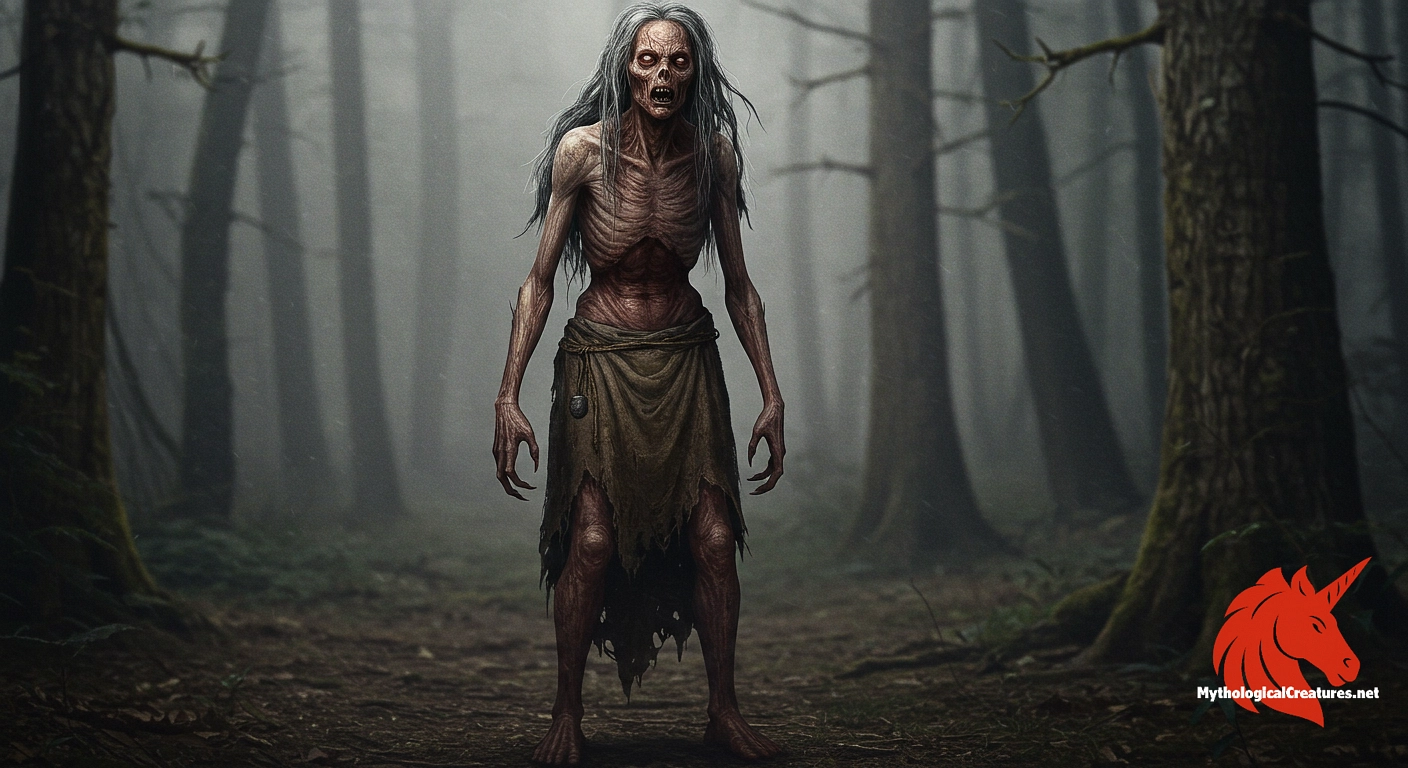Shtriga: The shtriga is a vampiric witch from Albanian folklore known for draining the blood of infants at night.

Shtriga
Shtriga - Represents the dark side of witchcraft in Albanian folklore and illustrates the fear of vampirism and supernatural exploitation.
Origins & First Encounters
Deeply embedded in Albanian folklore, the shtriga emerges as a formidable vampiric witch whose eerie reputation has spanned centuries. Born out of ancient oral traditions, her legend has been passed down through generations, evolving alongside cultural beliefs and societal norms. Early attestations of her existence suggest a figure steeped in mystery and malevolence, whose actions served as both a warning and a curse within small communities. Her fearsome traits, such as draining the blood of infants, underscore the intersection of natural superstition with the supernatural. The shtriga’s myth reflects a blend of pagan influences and early Christian moral codes that sought to explain the inexplicable. As a creature of the night, she symbolises the dangers lurking in shadowy, unregulated spaces and the fragile boundary between life and death. Local narratives often portray her as a fearsome embodiment of dark feminine power, challenging societal expectations of womanhood. Overall, this legendary figure continues to captivate imaginations, serving as a poignant reminder of a past imbued with ritual, mystery, and cautionary tales.
Source Texts & Tale Variants
The contours of the shtriga myth have been extensively chronicled in a variety of folklore collections and anthologies, alongside scattered references in historical manuscripts. Scholars and folklorists have long drawn from oral traditions collected during the 19th and 20th centuries to piece together her complex character. Some texts recount her tale with precision, detailing the specific conditions of her nocturnal hunts and her unique method of transformation. In other story variants, the creature is imbued with an ambiguous duality, where her dark acts are paradoxically linked to a form of healing. Accounts differ markedly from one locale to another, with some regions recounting elaborate rituals to ward off her influence while others focus on her solitary existence in the depths of the forest. Traditional storytellers have enriched her narrative through subtle alterations in tone and symbolism depending on regional beliefs. The multiplicity of sources has created a patchwork of interpretations, ensuring that no single version fully encapsulates her myth. Consequently, these diverse records underscore a layered history that continues to intrigue both academics and enthusiasts of myth.
Form & Powers
The shtriga is often depicted as a grotesque figure whose physical appearance is as multifaceted as her legend. A common portrayal is that of an ageing woman, her face scarred and disfigured by the passage of dark, magical years, and her eyes burning with a hateful intensity. She is frequently illustrated wearing a tattered cape, which adds an air of both decay and mystery to her silhouette. Her discolouration and pallid skin evoke the unsettling aura of one touched by unearthly forces. Many depictions also highlight her ability to transfigure, manifesting as a winged insect such as a moth, fly or even a bee, with delicate yet eerie wing patterns. Some accounts suggest that her insect form carries an otherworldly luminosity, contrasting sharply with her human guise. Variations in her size and demeanour accentuate her transient nature, at times appearing diminutive and frail, yet other times imposing and daunting. These layered descriptions, combined with artistically rendered details in traditional illustrations, have cemented her image as a being at once repellent and fascinating.
Regional Faces
Within Albania, the shtriga legend displays a rich variety of regional nuances that enhance her mystique. In certain mountainous and rural areas, she is depicted as a reclusive spirit who haunts not only dense woodlands but also the ancient ruins and abandoned cottages scattered across the landscape. In contrast, stories from more fertile plains portray her as a cunning and mobile entity, capable of infiltrating village life through the guise of a seemingly benign old woman. Some localised traditions even recount elaborate methods for both repelling and appeasing her, interweaving her narrative with broader community rites. Across the neighbouring Balkan regions, echoes of the shtriga can be discerned in similar warnings about nocturnal predators and otherworldly witches, though each culture bestows its own symbolic interpretations. Urban adaptations of the myth have emerged in more recent times, merging traditional elements with modern societal anxieties. These regional adaptations have allowed the shtriga myth to remain flexible, continuously absorbing and reflecting local cultural motifs. Ultimately, her story is as varied as the landscapes it inhabits, marking her as a versatile and enduring symbol of fear and caution.
Cultural Parallels
The shtriga bears fascinating resemblances to other mythic entities found across European folklore, underlining a shared tapestry of supernatural archetypes. Comparable figures, such as the Romanian strigoi and various Slavic vampire legends, share the core element of nocturnal predation and an unsettling transformation ability. These cross-cultural similarities hint at a collective psyche that is preoccupied with the mysteries of darkness and the vulnerabilities associated with nightfall. Some traditions even draw comparisons between the shtriga and the Greek lamia, both of which embody a dangerous fusion of human corruption and otherworldly power. While the shtriga possesses distinctly Albanian cultural traits, her narrative parallels contribute to an overlapping mythos characterising evil in multiple forms. Elements such as the dual capacity to harm and occasionally heal further enhance the complexity of her character in comparative terms. These inter-cultural connections provide valuable insights into how similarly themed legends have evolved independently while sharing common symbolic narratives. Such comparisons enrich our understanding of the shtriga, situating her within a broader European dialogue on the nature of horror and the supernatural.
Legacy & Modern Evolution
Over the centuries, the shtriga has undergone a remarkable transformation in public perception and artistic representation. Once solely a figure of terror lurking in the dark, her myth has been reinterpreted in modern times as a subject of sociocultural and psychological inquiry. Contemporary portrayals often explore the shtriga’s role in symbolising the marginalised and the misunderstood, highlighting the duality of her curse and potential cure. This evolution reflects a broader shift in how ancient figures can be reimagined to comment on modern issues such as the dangers of isolation and the complexities of female agency. Film, literature and visual art have all embraced the shtriga as a multifaceted character, capable of both horror and tragic pathos. Modern narratives sometimes present her as a tragic antihero, whose monstrous visage masks inner conflicts shaped by centuries of prejudice and fear. Although her traditional blood-draining imagery remains a potent element in rural superstitions, today’s retellings tend to focus on the metaphorical implications of her story. In this way, the shtriga continues to evolve, bridging historical superstition with contemporary explorations of identity, power and transformation.
Interesting Fact
An intriguing aspect of the shtriga's myth is the idea that only she can cure the condition she inflicts, suggesting a paradoxical control over both harm and healing.
Quick Creature Info
Associations:
Our Mythic Legendary Rating:

Also Sometimes Known As:
Habitat:
Supernatural Powers:
Physical Attributes:
Abilities:
Behavior:
Lore:
Related Creatures, Tales or Lore
- SStrigoi
- SStrega
- VVampire Witch
References
Discover Another Mythical Legend You May Not Have Heard Of?
Uncover the mysteries of ancient folklore and expand your knowledge of legendary beings from cultures around the world.
Dare to Meet the Lýtir....
Mythical Disclaimer: The images and data on this site are derived from various historical and literary sources, but we have found that many myths often have multiple versions and interpretations across references, sometimes contradictory. As a result, these creature depictions are artistic interpretations—imaginative blends of folklore, legend, and a dash of AI guesswork. Because creature descriptions vary widely, our illustrations and accompanying information represent our best effort to honor mythology while bridging creative gaps. Enjoy these interpretations—just remember, we've done our best to respect the stories and validate available data, but in the realm of mythology, details often shift, imagination leads the way, and nothing is ever set in stone!
Curated by the Mythological Creatures Team (rev. May 2025)
